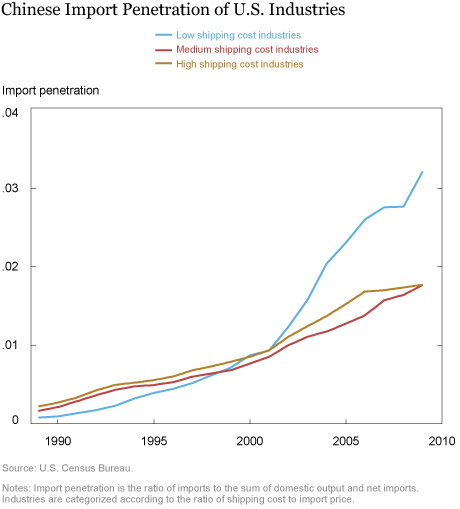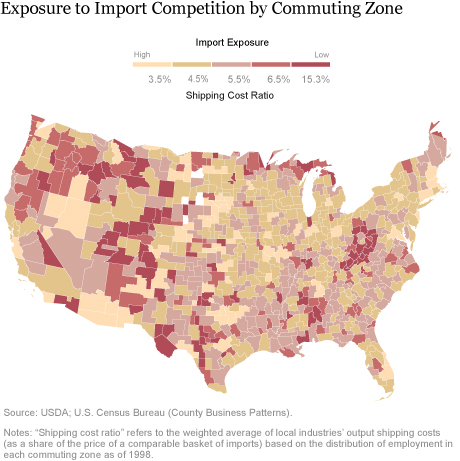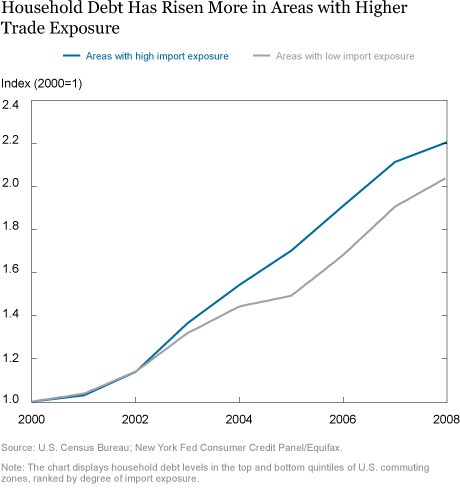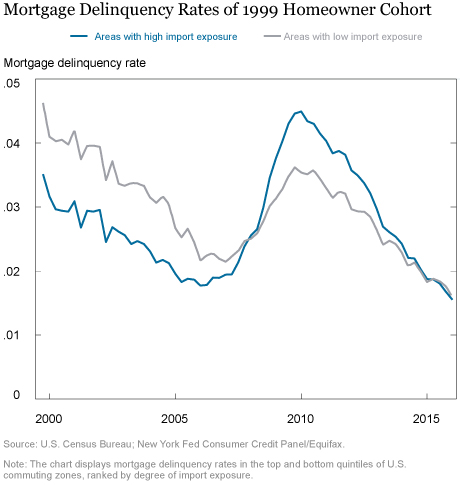In the years preceding the Great Recession, the United States experienced a dramatic rise in household debt and an unprecedented increase in import competition. In a recent staff report, we outline a link between these two seemingly unrelated phenomena. We argue that the displacement of workers exposed to import competition fueled their demand for mortgage credit, which left many households more vulnerable to the eventual downturn in the housing market.
Using Shipping Costs to Measure Import Competition
To determine differences in import competition across the United States, we use industry-level shipping costs based on Census Bureau data. Shipping costs are a natural impediment to international trade—domestic industries that have low shipping costs relative to the value of the goods they produce, for example, are more exposed to imports than those with high shipping costs. Shipping costs as a percentage of import price can vary widely, from as low as 1.5 percent for electronics to as high as 8.5 percent for coal and minerals, and that variance can translate into substantial differences in import competition. The figure below illustrates that after China was admitted to the World Trade Organization in 2001, U.S. industries in the bottom tercile of the shipping cost scale experienced significantly more import penetration from China than those in the higher terciles.

We measure geographic differences in import competition by taking the weighted average of shipping costs in each commuting zone based on the distribution of employment across industries as of 1998. The map below shows that areas with greater exposure to import competition—that is, commuting zones that produce lower shipping cost goods—are scattered throughout the United States.

Import Competition and Household Debt
While our study confirms prior research showing that import competition can reduce employment and slow wage growth in exposed industries (Autor and Hanson, 2013), we go a step further to consider how that labor market pressure affects household finances. We measure household debt for each commuting zone using a nationally representative panel data set of consumer credit records, the New York Fed Consumer Credit Panel/Equifax (CCP). The figure below reveals that households in commuting zones that were more exposed to import competition (by virtue of having low shipping costs) took on substantially more debt than households in zones with low import competition exposure. Note, however, that debt rose even in less exposed areas, indicating that import competition alone does not explain the boom in borrowing that occurred in the early 2000s.

The paper conducts a regression analysis that allows us to isolate the impact of import exposure on household debt while controlling for differences across commuting zones with respect to home price growth, demographic characteristics, and credit scores, among other factors. We estimate that a typical (one standard deviation) increase in shipping costs is associated with a 5.7 percent increase in aggregate household debt, which accounts for about 30 percent of the cross-sectional variation in household debt growth from 2000-07. In other words, import competition explains a significant portion of the regional differences in debt growth seen across the country during that period.
How Did Households Borrow?
The largest category of additional borrowing was mortgage debt. Using Home Mortgage Disclosure Act (HMDA) data on mortgage loans, we find that refinancings increased to a greater extent in areas exposed to import competition. Using the CCP, we discover that equity extraction—increasing leverage on an existing home via increased mortgage borrowing—increased in high-exposure/low-shipping-cost areas.
If borrowers are extracting equity value from their homes in response to labor market distress, we would expect areas with higher home price appreciation—and hence higher home equity—to increase debt more in response to higher import competition. Indeed, we find that debt grew more for low shipping cost areas that experienced high home price growth. Taken together, these findings suggest that the incremental debt growth attributed to import competition was principally the result of households increasing leverage on existing homes.
Financial Consequences
We find that areas exposed to import competition experienced more delinquencies and foreclosures in the 2008-11 period and that these effects were even more pronounced in areas where home prices appreciated more in the 2000-07 period. The chart below illustrates that the mortgage delinquency rate increased more in low-shipping-cost areas that are more exposed to import competition than in high-shipping-cost areas—despite the fact that low-shipping-cost areas generally had lower delinquency rates historically (2000-07).

Why Did Households Borrow?
One explanation for why consumers borrowed in response to import competition and labor market distress can be found in the permanent income hypothesis, which predicts that consumers will use debt to smooth consumption in response to transitory shocks. If workers believed the impact of import competition would be temporary, then under the permanent income hypothesis, they would borrow in order to reduce the impact on their consumption. We explore the re-employment expectations of affected workers in the paper and find that unemployed workers from industries exposed to import competition were too optimistic about their re-employment prospects, consistent with a belief that the shock was temporary.
Final Thoughts
Our research documents distributive effects of globalization and the role mortgage markets played in absorbing them. Our work focuses on a previously unexplored aspect of globalization—its impact on household balance sheets and the resulting increase in households’ sensitivity to economic shocks. Our work does not consider the many benefits of free trade that have been documented in the academic literature and should not be viewed as a comprehensive analysis of the pros and cons of trade.
While we do not draw strong conclusions on trade, we do make a more narrow policy observation. One result in the paper suggests that households increased borrowing to a lesser extent in areas with more generous unemployment benefits, suggesting that social safety nets like unemployment insurance can reduce the risky use of housing equity to buffer against labor market shocks.
Disclaimer
The views expressed in this post are those of the authors and do not necessarily reflect the position of the Federal Reserve Bank of New York or the Federal Reserve System. Any errors or omissions are the responsibility of the authors.
Jean-Noel Barrot is an associate professor of finance at the MIT Sloan School of Business.
Erik Loualiche is an assistant professor of finance at the University of Minnesota Carlson School of Management.

Matthew Plosser is a senior economist in the Research and Statistics Group at the Federal Reserve Bank of New York.
Julien Sauvagnat is an assistant professor of finance at Bocconi University.
How to cite this blog post:
Jean-Noel Barrot, Erik Loualiche, Matthew Plosser, and Julien Sauvagnat, “Did Import Competition Boost Household Debt Demand?,” Federal Reserve Bank of New York Liberty Street Economics (blog), January 17, 2018, http://libertystreeteconomics.newyorkfed.org/2018/01/did-import-competition-boost-household-debt-demand.html.











 RSS Feed
RSS Feed Follow Liberty Street Economics
Follow Liberty Street Economics